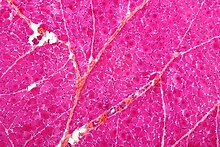Congenital distal spinal muscular atrophy
| Congenital distal spinal muscular atrophy | |
|---|---|
| Other names |
|
Paediatrics, medical genetics | |
Congenital distal spinal muscular atrophy (cDSMA), also known as distal hereditary motor neuropathy (or neuronopathy) type VIII (dHMN8), is a
Signs and symptoms
The presentation is as follows:[medical citation needed]
- Neurogenic muscle weakness
- Atrophy (of lower and upper limbs)
- Club foot
- Arthrogryposis
- Scoliosis
- Platyspondyly
- Pes cavus
- Vocal cord paralysis
Causes
Congenital distal spinal muscular atrophy is caused by a mutation of the TRPV4 gene found on the 12q23-12q24.1.[3] The mutation causes an affected individual to have lower levels of TRPV4 expression. This deficiency can lead to abnormal osmotic regulation. Congenital dSMA is genetically heterogeneous, meaning a mutation on this gene can cause a plethora of other phenotypically related or phenotypically unrelated diseases depending on the region that is mutated.[citation needed]
Pathophysiology
The TRPV4 (transient receptor potential vanilloid 4) gene, located on
Mechanism
The ankyrin repeat domain (ARD) is a region located near the intracellular N-terminal of the TRPV4 protein and consists of six ankyrin repeats. Four missense mutations have been identified at three specific positions all located within the ARD. All of these mutations are due to the swapping out of arginine with a different amino acid.[7] Arginine is highly polar and positively charged, while its replacements are less polar or nonpolar. Some of these identified amino acid substitutions are:[medical citation needed]
- R296H, arginine to histidine substitution
- R315W, arginine to tryptophan substitution
- R316C, arginine to cysteine substitution
- R594H, arginine to histidine substitution
Diagnosis

Electrophysiological evidence of denervation with intact motor and sensory nerve conduction findings must be made by using nerve conduction studies, usually in conjunction with EMG. The presence of polyphasic potentials and fibrillation at rest are characteristic of congenital dSMA.[6] The following are useful in diagnosis:[medical citation needed]
- Nerve conduction studies (NCS), to test for denervation
- Electromyography (EMG), also to detect denervation
- X-ray, to look for bone abnormalities
- Magnetic resonance imaging (MRI)
- Skeletal muscle biopsy examination
- Serum creatine kinase (CK) level in blood, usually elevated in affected individuals
- Pulmonary function test
Management
Congenital dSMA has a relatively stable disease course, with disability mainly attributed to increased contractures rather than loss of muscle strength. Individuals frequently use crutches, knee, ankle, and/or foot orthoses, or wheelchairs.[2] Orthopaedic surgery can be an option for some patients with severely impaired movement. Physical therapy and occupational therapy can help prevent further contractures from occurring, though they do not reverse the effects of preexisting ones. Some literature suggests the use of electrical stimulation or botulinum toxin to halt the progression of contractures.[8]
